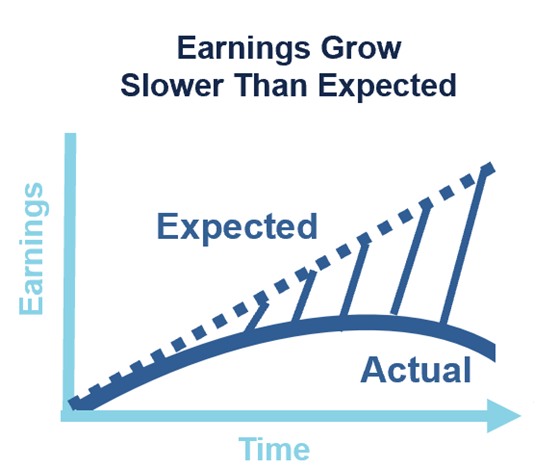Incorporating Economic Risk for optimal portfolio construction. We believe that conventional methods for describing individual…
CastleArk Investment Process: Exploiting Inefficiencies
Discovering Biases in Company’s Earnings Outlook
As investors, we are in constant search for companies whose stocks are mispriced relative to their forward earnings paths. We believe the odds of success are greatest when investors expect a company to grow earnings either faster or slower than practical, creating an opportunity to own or exit a holding. Identifying investor overconfidence that a business can sustain rapid growth or fear that one cannot, underlies our investment process.
Built on the premise that emotion plays a role in market behavior, Behavioral Finance theory has identified tendencies like herd mentality, loss aversion and anchoring as non-fundamental drivers of financial market returns. We use these concepts to identify anomalies between a stock’s current valuation and its more likely long-term outcome. Our investment process begins with our bottom-up assessment of a company’s forward earnings trend and compares it to market expectations. When stocks that price a faster-than-likely forward earnings path, we look for behavioral biases to explain the difference. Depending on the bias, the potential for disappointment can be quite large. Similarly, when we find stocks that price a mediocre growth path for a business with exceptional prospects, we see opportunity that is incorrectly biased by a behavioral driver. Combining fundamental analysis with behavioral elements gives us an edge that applies to all markets and strategies.

For example, investors in large, more established businesses, tend to project longer or more sustainable earnings paths than a business can support. Because most of these companies have already demonstrated success, their forward projections–and the value placed on them—often reflect a false sense of security, (anchoring). This leads to earnings projections that cannot be supported by the size of the market or the competitive landscape the company is entering. Understanding this allows us to avoiding stocks whose earnings are destined to disappoint, while focusing on the ones with more durable outlooks that can match or exceed expectations.

Among investors in smaller companies, we often find the opposite tendency. Because these firms have shorter, more volatile histories, investors are often biased towards caution, (loss aversion), and take a more guarded view of a business in the early phase of a new product or market introduction. Because of this bias, the potential for expected earning growth can be priced well below the actual outcome. When we identify this condition, we find the potential for a higher-than-expected returns.
Discovering bias in a company’s forward outlook is key to distinguishing between an investment with a downside or an upside opportunity. By using sound, fundamental assessment of the forward earnings and comparing it to expectations embedded in the stock price, we can exploit behavioral bias and earn higher returns for our clients.
